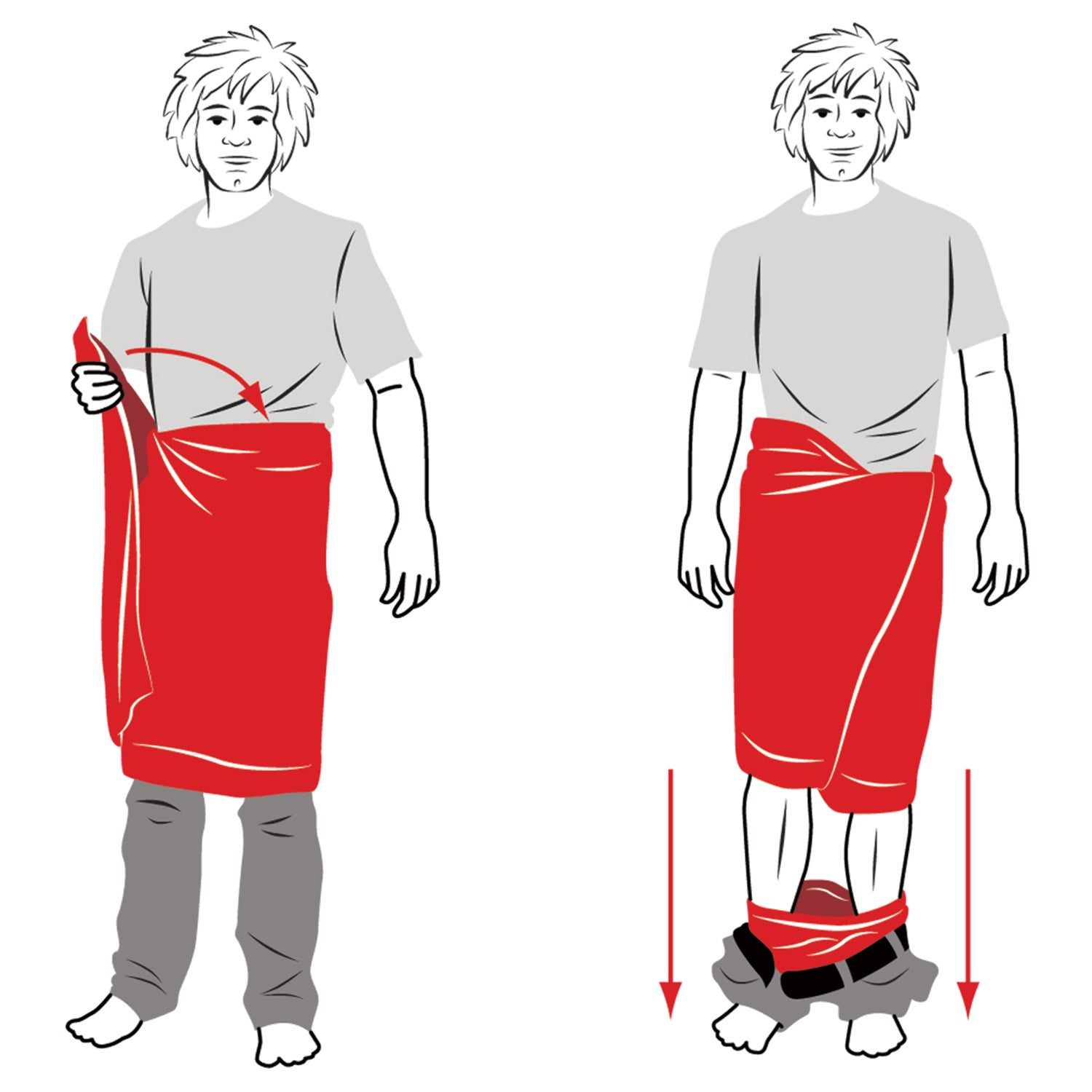Learning something new every day just ain't enough, so we rounded up a herd of pros, experts, and autodidacts; interrogated them (gently); and laid down their secrets here. Dig in to our encyclopedic array of do-it-yourself intelligence and discover the right way to climb high, fool fish, brew beer, abandon ship, get frisky in midair, and much, much more.
1. Fake a Sick Day

Brilliant tactics from , a.k.a. Toby Flenderson, the human resources dude on NBC’s :��
- Fake two sick days (you got it BAD), in the middle of the week. If possible, schedule them so you miss a “fun” work event, like a special (free) lunch.
- Rent some movies the first day; play outside the next. If caught, say you’re feeling better but are still contagious. Tell the person who catches you that you don’t want to touch or breathe on him.
- Once you’re back at work, never imply that you took some “time off.” Instead, say, “Believe me, that was a hard time.” trust no one with the truth—absolutely no one.
- Be prepared for the fact that some will never believe you were sick, but it’s their job to pretend to believe you. And the sad/happy truth is, as long as no one has to do your work for you, no one really cares whether you’re there or not.
2. Fix a Motorcycle (With Your Teeth)
Pop! That’s the sound of trouble on two wheels. If your clutch cable snaps, you can find yourself stranded a long way from home, in the wrong place at the wrong time. It happened to me eight years ago in Cambodia while riding a rented motorbike between Khmer Rouge and government positions after a day of negotiating for interviews with Maoist maniacs. I coasted to a stop. It was sunset, and I was ten miles from safety in a heavily mined no-man’s-land of poisonous snakes and AK- 47-toting farmers, with a bunch of murderers on my tail. You’re always told to pack a spare cable, and I did—inside my saddlebags, 6,000 miles away. In the real world, there are often no parts, few tools, and less time, so:
- Use a rock to smash open the cable’s metal tip.
- Strip back the plastic covering (your teeth will work).
- Find the broken wire and bite it.
- Pull.
- Knot the stub around a small pebble.
- Slot it all into the bottom of your clutch handle.
- Get outta Dodge.
3. Be Fearless in Whitewater
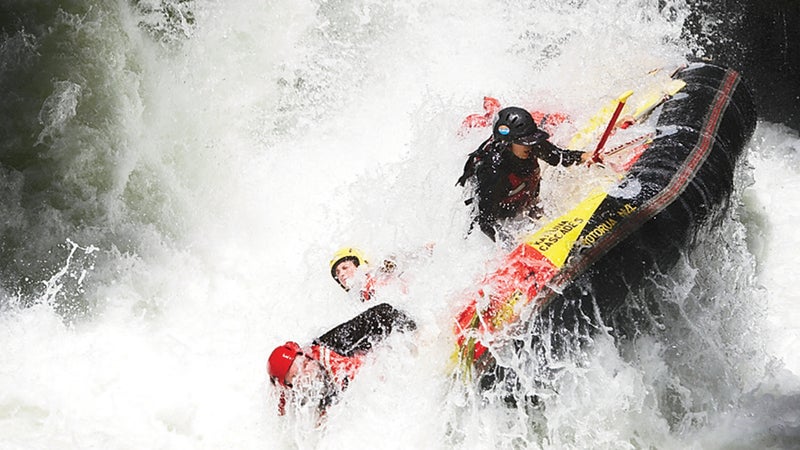
“It’s hard to be fearless,” says pro kayaker Brad Ludden. “That’s half the reason you do it.” But to boost your confidence in big water, use these tips:��
- It’s OK to be nervous while scouting. But once you’re in the boat, total confidence is the only option.
- Look where you want to go. Cringing at those huge holes in your line can land you in them. Focus: Even Class V rapids have clear lines.
- Practice the hard moves in easy rapids. Ferrying, eddy hopping, and surfing are the basics of every skill level. “When you’ve got it,” says Ludden, “kayaking becomes a sort of meditation.”
4. Brew a Seasonal Beer
Ah, the dog days! High beer-swilling season! Which means trips to the store, which mean getting out of the hammock, which is unfortunate—and just another great excuse to brew your own, which is why we asked BeerTown.org’s Ray Daniels, author of, to provide a delicious, foolproof summertime recipe. Inspired by Belgian witbier but with a tropical twist from West Africa, it’ll be ready to enjoy in 20 to 30 days.
Paradise Summer Ale:��
5 lbs wheat-malt extract
1 oz pelletized centennial hops
1 packet dry ale yeast
1 oz grains of paradise, crushed.
Boil three gallons of water; remove from heat, add extract, stir until dissolved; add all but a quarter-ounce of the pellets, return to heat, boil while stirring constantly with a long wooden spoon for 40 minutes; add grains of paradise, remaining hops, and two more gallons of water; kill the fire. Makes five freakin' gallons (about 53 trips to the head). Kit and ingredients, with fermentation and bottling instructions, .

Choose Your Suds Wisely
Ever since Seoul, South Korea, native and chef Sang Yoon—a self-described beer sommelier—ditched five-star cuisine to reinvent the Santa Monica pub , he’s been ballyhooed for his awesome beer menu. Here are his
top summer sippers:��
- Grilling? Alaskan Smoked Porter: nice and rich; you’ll look like a genius.
- Beach-Bumming? Allagash White: cool, tart, fresh; goes well with that ubiquitous smell of coconut.
- Climbing? Pabst Blue Ribbon: Use the can as a signal mirror if you can’t climb home. (Locate the first two with ’s “beer finder.”)
—���������پ��������ٱ����Ա���ٳپ�
5. Make a Power Smoothie

A creamy (oooh!), chocolatey (aaahh!), treat-your-self snack packing the perfect recovery ratios of protein, fiber, and heart-healthy fat—because you earned it (yes, I did!):��
1 banana
2 tbsp natural peanut butter
3 tbsp un- sweetened cocoa
1 cup fat-free milk
3/4 cup ice
1 tbsp honey
2 tbsp flax-seed, ground
2 tbsp wheat germ, ground
Blend until smooth; makes two servings. 402 calories, 49 g carbs, 18 g protein, 19 g fat, 14 g fiber. Find more recipes in , by correspondent Chris Carmichael, founder of .
6. Play the Farmers’ Market
Leave the waxed stuff to the big chain stores, follow these orders from pioneering organic chef Alice Waters, owner of Berkeley bistro , and hit the market prepared for action: First, look around to see what’s fresh. Have a rough idea of what you need and buy essentials first. Then see what else is ripe.
- Don’t assume all crops are locally grown. Seek out regional sustainable farmers and you’ll probably get produce picked that morning.
- Check for the presence of vibrant stems and leaves, sure indicators of freshness.
- No one knows the produce better than the farmer, so ask for tips on storing and cooking. You might end up with a secret family recipe.
- Try one new, seasonal ingredient each week to spice things up. (Find local grub bazaars at .)
7. Drink Without a Corkscrew
You’re an idiot. In the middle of nowhere. With a bottle but no tool with which to liberate the vino languishing within. Fret not: You can get at that good stuff. You can even choose whether to bow to thirst or decorum: Don’t overthink it; just jam the cork into the bottle, gingerly decant, and plan to drink it all that night. Too gauche for you? Then ram the butt of the bottle against a tree (trust me) until the cork rises enough for you to take the tip of a blade and pry it out little by little—in a spiral- staircase pattern, so as not to break it. Or you can keep ramming until it sticks up far enough to yank it out. Now quaff like Falstaff.
—Jeremy Spencer
8. Get Picked for Pickup Hoops
Basketball at the park may do just fine without refs, but that doesn’t mean there are no rules. While playing at 200 courts across the country, and sizing up many more, for his book , compiled some nearly universal guidelines for interlopers hoping to fit in: Look the part by wearing basketball shoes and shorts, but don’t announce that you’re a poseur by rolling up in an NBA jersey.
- Figure out who has next game—or, if there’s a line, who’s last—by asking who’s got next or last. If there’s no room for you on the squads in line, call your spot at the end. Use your waiting time to study the house rules: Going to 11 or 15? By ones or ones and twos? Win by two or straight up?
- Start strong. Lead with a crazy shot and you won’t touch the ball again.
- Call fouls loudly and immediately, but be selective: The fastest way to devalue your stock is a “soft” call.
- If you’ve got an open shot within range, take it—after all, you’re here to play, right?
9. Perfect Your Form
You’re in a dumpy motel with no gym. Fine. Just lounge in your underwear, watch bad TV, and work out. All you need is the floor to bust out some push-ups, crunches, and squats, right? Wrong. Without proper form, you’re wasting your time. So we got founder Mark Verstegen to tell you how to make the classics count.
- Push-Up: With hands at sides and thumbs parallel to mid-chest, keep back and shoulders aligned, push up until before elbows lock. Hold for a beat; lower until elbows are at 90 degrees, slightly tucked in. Keep chest up and head down.
- Crunch: With heels on the floor, hands laced behind head, and chin slightly tucked, crunch sternum toward hips, rolling upward until shoulders are four to six inches off the floor. Hold for two beats before reversing in a steady, controlled movement.
- Squat: With feet shoulder width apart, toes forward, hands on thighs, “unlock” hips and squat as you reach arms up and out. The movement should come from the hips, and thighs should be parallel to the ground or close. Maintain a neutral spine, without letting your pelvis tuck under. Keep your shoulders, knees, and toes aligned. Keep chest up, shoulders down and back, and feet flat. (For all of these, remember to exhale through exertion.)
10. Escape an Attacking …

Baboon
Notoriously fast and wily, baboons sometimes assault people, have snatched crying babies, and can open car doors.
Trouble: If you’re standing between a female and her baby, watch out—the troop will gang-attack. Neither stare nor yawn; both mean “I want to fight” in Monkey. Stay out of the way, and never, ever feed one.
Tactics: Stand, shout, and clap. Still coming? You’re holding food. Drop the Twinkie. Slowly back away. Never let them see your bum.
�ѴǴDz�����
The bull, one of the largest mammals in the U.S., can top out at 1,600 pounds, stand six feet tall, and sport 50 pounds of antlers and six-inch hooves. This ornery ungulate has been known to kill; winter, with its tiresome snows, and autumn, when bulls are drunk on testosterone, are the most dangerous times.
Trouble: If its ears lie back, the hair on the hump of its neck stands up, or it clenches its teeth, it doesn’t like you.
Tactics: Run or get behind something big. Take off and most charges will end as bluffs. If not, says moose biologist Terry Bowyer, “you could be playing ring around the tree for 20 minutes.”
Elephant
The world’s largest vegetarians are responsible for an estimated 500 deaths a year. Get one riled up and as much as six tons could be steamrolling your way at 25 to 30 miles an hour.
Trouble: You smell eau de rotting flowers, urea, and Obsession. It’s a bull in musk. Angry elephants kick up dirt, swing their trunks, trumpet, and hold their floppy ears straight out.
Tactics: Get behind something really big. Nothing around? Run. Heading down a steep hill will slow Jumbo down.
—Joe Spring
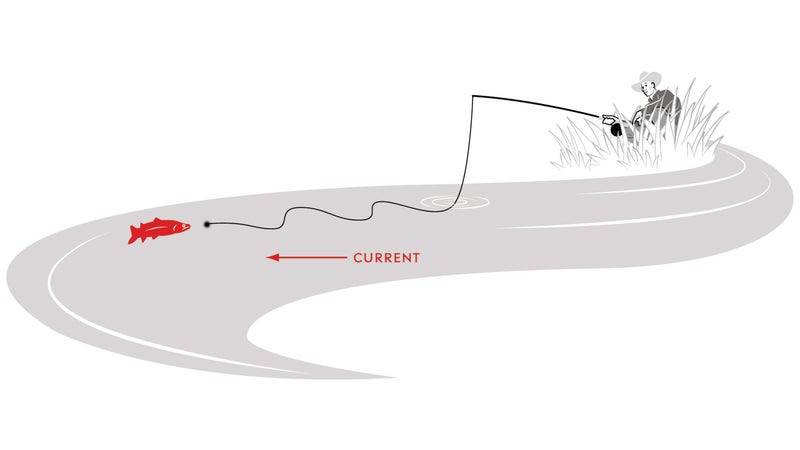
11. Land a Lunker at Flat Creek
Jackson, Wyoming’s Flat Creek is to fly-fishing what Pipeline is to surfing, so you’re bound to get skunked your first time out. “It’s part of the challenge with any spring creek,” says 15-year Flat Creek veteran Ned Hutchinson, a product manager for Cloudveil fly-fishing gear. Here’s how he gets his clients beyond “the one that got away” and into that magical place where Zen, an unhealthy attachment to Izaak Walton’s , and a fluttering heart collide: When you approach the water to scout, stay away from the edge. Better yet, belly-crawl. Cutthroat congregate under the cutbanks and will spook at almost any disturbance.
- Once you spot a worthy fish—18 inches or larger—watch it for a few minutes to time its rise pattern. Count the seconds between rises. Often, cut-throat stay down for a few minutes and then come up to eat three or four consecutive times. That’s when you strike.
- When it’s time to cast your flies—gray drakes, mahogany duns, PMDs, and sneaky terrestrials—presentation is all-important. Use a 12-to-15-foot leader and pick a spot where you can make a drag-free drift.
- Stack line slack in S-curves so a dragless fly is the first thing the fish sees. And try not to let the shadow of your casting line cross the fish. “Lining” a cutthroat is a sure way to scare it off. Now: Wait for it …
12. Hire the Right Trekking Guide

Eric Simonson, co-founder of , has led trips and hired help in Africa, South America, and throughout the Himalayas. Simonson says: look around. Google, post queries on forums (, ), and call reputable hotels.
- You want a guide with great communication; talk to candidates about how often they’ve done your itinerary, what to expect on the trail, and what they pay staff.
- Negotiate all costs up front, especially in Africa—park fees, in-country flights, tips, etc., can be hidden in the fine print.
- Trust your gut—if a guide doesn’t have his act together or won’t answer questions, move on.
- Help protect porters by following the guidelines at .
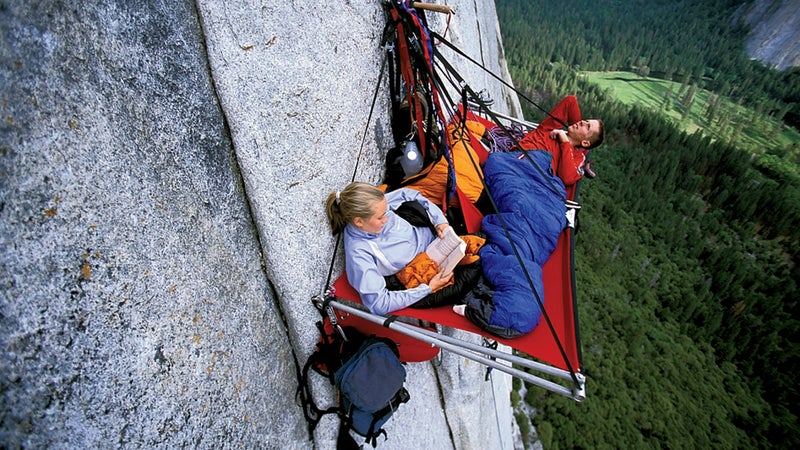
13. Shag on a Portaledge
So you’ve just climbed a 5.12 with a 10.0 and you’re all sweaty and hot and … OK, sometimes there’s no avoiding getting it on in that tiny bit of elevated shelter. According to one anonymous (and persuasive) climber and pro photographer (no, not Jimmy Chin), sex on a portaledge is a beautiful thing, dammit. “All models are going to be strong enough,” says … well, let’s just call him Rico, and Rico thinks Black Diamond’s roomy double portaledge ($700; bdel.com) scores highest for ethereal amore. But “when you let down the shark fin or middle dividers, you slide into a pit and can’t move much.” As with sex in a hammock, rolling around isn’t an option. Instead, choose one position (harnesses allowed) and commit; otherwise the ’ledge might get a bit tipsy. “Baby wipes also make things nicer,” he’s proud to share. TMI, Rico. TMI.
—J.D
14. Survive an All-Night Race
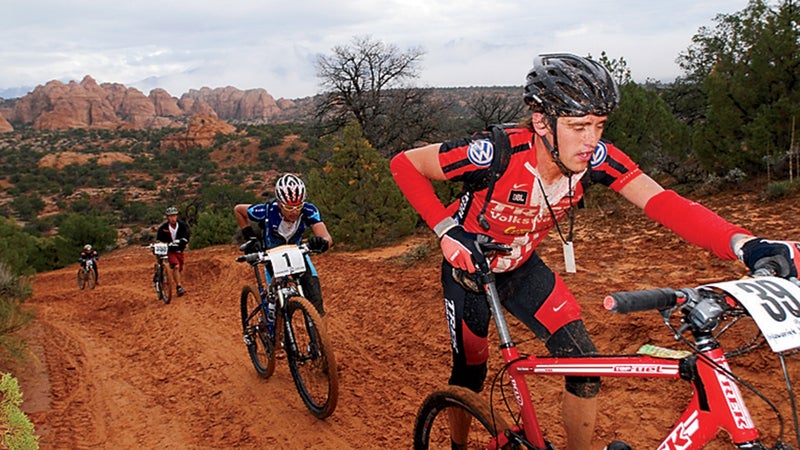
Golden, Colorado–based pro mountain biker Nat Ross has competed solo in at least three dozen twice-around-the-clock events—todays’ preeminent endurance sufferfests—most recently winning Utah’s in 2006. Here are his tried and true methods for making those long, hard rides as painless as possible: check ride424.com, pick your race, and give yourself six weeks to prepare. Get your bike properly fitted to your body (see ), then work in some four-to-six-hour sessions and night rides, and train after meals to get used to going hard after eating.
- Start out at a comfortable pace—it takes a few laps to get your nerves unjangled—then settle into a groove and stay hydrated.
- Munch on the go: fruit, burritos, mashed potatoes, ravioli.
- Rotate water and sports drinks, using different hydration packs for each, and go for 50 to 70 ounces per lap.
- Prevent blisters: Switch gloves and socks, use chamois cream on your nether regions, and align and tighten your cleats.
- Layer for a balance of warmth and wicking.
- Oh, yeah: Have fun.
15. Master the Flick
Your classic backhand throw is great for less intense sessions that may or may not involve doobie and bare feet. But in the hard-charging realm of ultimate Frisbee, the full-field forehand, or flick, is king. Josh “Zip” Ziperstein has won college ultimate’s version of the Heisman, a national championship while at Brown University, and a gold medal at the World Games, so we asked him how he gets 175 grams of plastic to make like a thunderbolt flung off Mount Olympus.
- Grip: Place pointer and middle fingers on inside rim of disc, ring and pinkie along outside rim. Grip topside edge with thumb. Extend middle finger and press firmly against ridgeline between inside rim and flat bottom. Press pointer firmly against middle finger.
- Pivot, set, and wind-up: Step out laterally, with leg on throwing side bent at knee. Bring disc behind stabilized body with arm cocked, poised to release, like an open tennis forehand.
- Throw: Quickly and fluidly bring disc forward, parallel to ground. Snap wrist upon release, as elbow straightens and disc moves past hip. For extra power and distance, step slightly forward with throwing leg, rotating hips away from throwing arm.
16. Leave a Motel Room
By Ian Frazier
The act touches on mortality. It offers a small dose of the autobiographical sadness you feel after the moving van has gone and you take a last look around the place where you used to live. Travelers who must face this experience on a daily basis should brace for it with stoutness of heart and the comfort of ritual.
First, shower. Then put on all the clothes you expect to wear that day. (Your coat may be left until right before departure.) Fill your pockets with everything you normally carry, except for the room key. Place that in a prominent spot on top of a few singles or a five, for the cleaning people or the demons of the room.
Pack your briefcase. Pack all other gear, and then your clothes. Take the suitcase out to the car first, leaving the room door ajar. (I flick the little metal-bar thing across the frame to keep it open.) Come back for your other gear. Leave your briefcase with the most important stuff last.
The slamming of car doors in the morning is the unwelcome rooster crow of the motel world, so I make it a point of honor to avoid slamming anything. Ideally, in good weather, I like to load up and leave without closing any car door more than twice. When the car is loaded, it’s time for a final look around the room. Check the closet—and always remember the little hook behind the bathroom door. (I’ve left a lot of pajamas on those hooks.) For the very last, I always get down and look under the bed. I have never once found any forgotten object there, but I always check just the same. On family trips when I was little, my father always used to do that last of all. He has been dead now for 20 years; I like to imprint on my mind the same under-motel-room-bed vista that he saw. At this moment of transience, it gives me a reassuring sense of eternity.
—Ian Frazier collects wrappers from motel soaps. His favorite is called First Date
17. Stroll Away from a Fall
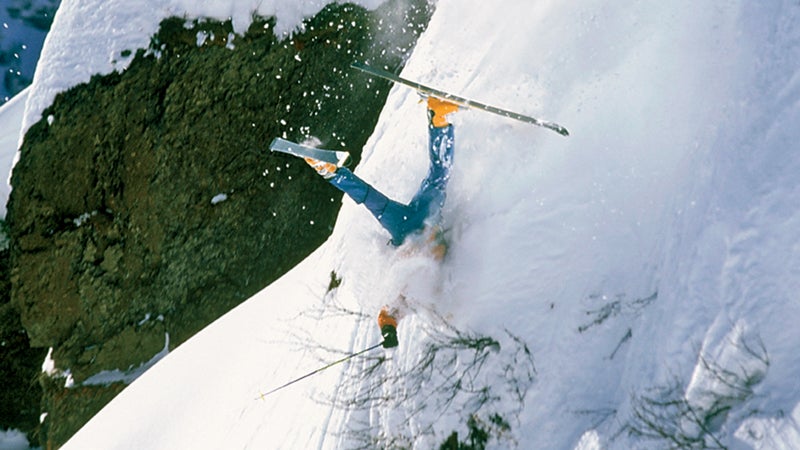
Riding the ragged edge of your skill level is key if you want to break through in any sport, so brutal endoes, yard sales, and whippers are de rigueur. Soften those blows with a little preemptive TLC from the experts: Most mountain-biking falls occur at slow speeds, says former world champion (and eternal badass) , and appropriate pedal tension will help you unclip before stalling out. Going ass over teakettle? “Put your hands out,” he says. “As soon as they touch ground, recoil your arms, tuck to one side—whichever is more comfortable—and roll across your back to avoid any jolting impact to your outstretched arms or shoulders.”
- A hyperex-tended thumb is a nasty skiing injury, but a torn medial collateral ligament (MCL) is a real nightmare, says Dr. Kevin Plancher, an official surgeon for the U.S. ski and snowboard teams. Prevent these common boo-boos by closing your fists and sitting into a fall, which can save your knees from hyperextension.
- To weather a roped-lead fall while climbing, keep your arms free and make sure you don’t get inverted by tangling the rope around your legs, advises Don Mellor, author of 2001’s American Rock. Use your hands to protect yourself from outcrops, but be wary of pushing off the face of a cliff; the more you push, the more, and harder, you’ll swing back.
—M.G.
18. Run Like the Wind

Or the breeze, whatever. The three keys, according to Chris Carmichael, are a smooth stride, explosive power, and a strong torso. Here’s how to get them:��
- Strides, not all-out sprints, mean running as fast as you can while focused on form: back straight, head up, arms pumping in a straight line. Work them into normal runs, four reps of 20 seconds, resting 60 seconds between intervals. Best off pavement.
- Skipping improves fast-twitch muscle fibers and anaerobic power. Work in two sets of three 30-second reps; jog a minute between reps, three minutes between sets.
- Planks create core strength, which generates a quicker, more efficient stride—otherwise you’re just flailing. Start in a modified push-up, on your forearms. With legs, torso, and head in a straight line, hold for 30 seconds. Three mornings a week, four reps, resting 30 seconds between. Work up to holding the pose for a minute.
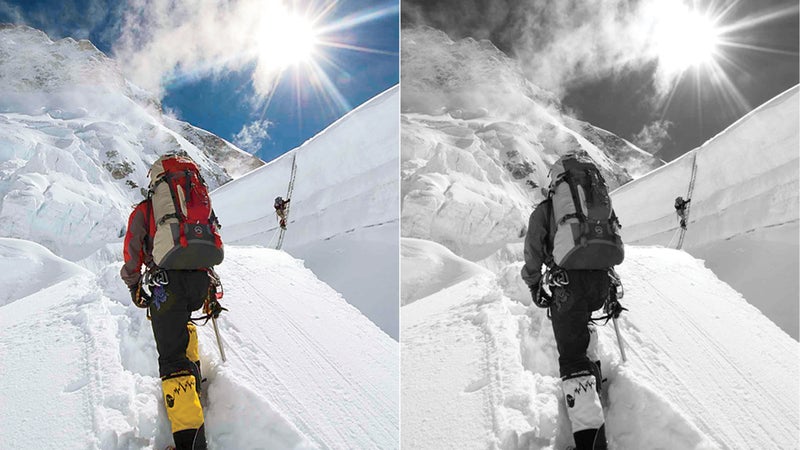
19. Create a B&W Digital Photo
Make a nice black-and-white by shooting digitally in color and converting using Adobe Photoshop, advises mountaineer and photographer Jimmy Chin: “Most people make the mistake of discarding the color information or desaturating the picture,” he says. “Instead, use the channel mixer to fine-tune tone and contrast.”
- From the “image” menu, select “adjust,” then “channel mixer,” and check the monochrome box to grayscale it. Determine the dominant colors—red, green, or blue—in your shot.
- Add red to give skin tones more contrast, blue to brighten snow and ice. If the combination of numerical color values adds up to more than 100 percent, balance luminosity using the “constant” slider.
- Finally, be subtle. Unless they’re Civil War reenactors, no one wants to look like they’re in a daguerreotype.
20. Drive on Sand
When the sweetest surfing or fishing spots are way the hell down a long (vehicles-allowed) beach, do like ranger Wouter Ketel, of North Carolina’s (and don’t, like, forget to check the tides): Take a 4×4 with good clearance.
- Mud and snow tires dig into sand; radials float. Drop them to 18 or 20 psi for better traction.
- When you hit a soft section, don’t stop; use your momentum or a slow acceleration to get through. And try not to make quick turns.
- If you start to sink, don’t spin your wheels—you’ll go deeper. Dig the sand away, lower pressure a bit more, and jam a board under a tire for grip—but keep in mind the possibility of said board hurtling toward yon innocent bystanders.
21. Cook a Perfect Meal
Appetizers
Chilled dungeness crab with homemade cocktail sauce; deviled eggs; prosciutto-wrapped grilled figs
���Գٰ�é��
Cedar-planked wild salmon; salad of whole-grain pasta and grilled vegetables; spicy greens with fresh cherries, goat cheese, and cherry balsamic vinaigrette
Dessert
Summer-berry-and-olive-oil polenta cake; grilled peaches
Besides the fact that you’re drooling, what's so perfect about this menu? It’s a balanced recovery feast* that follows the 40-30-30 ratio of carbs to fat to protein prescribed by nutri- tionists—and is damn delicious, too. “Chefs are concerned most about taste,” says Vitaly Paley, owner of Portland, Oregon’s award-winning . “This meal is varied enough in flavor to keep the palate always wanting more.”
To hit that recovery-ratio sweet spot, Paley teamed with USA Cycling coach and flavor-savvy nutrition nut Michael Manning. “The protein sources are all high-quality,” says Manning. “The majority of the fat comes from olive oil, rich in monounsaturates. This reduces cholesterol for a healthy cardio-respiratory system. The salmon is a primary source of essential fatty acids, which improve metabolism and work to reduce inflammation. The majority of the carbs are from fresh fruits and vegetables and provide superior nourishment with antioxidants and other phytonutrients, in addition to supplying fiber.”
Salivation is at hand.
—Gordy Megroz
*2,032 calories; replaces the energy burned by a 155-pound male on a 2.5-hour bike ride at an average of 17 mph.
22. Survive a Bar Fight

Anyone who’s been in a real rumble will tell you it’s a far more brutal affair than your choreographed fantasies of kicking ass like Patrick Swayze in . “A fight is a no-win proposition,” says Peyton Quinn, 57, self-defense instructor, former bouncer, and author of . “You either go to jail, the emergency room, the courtroom, or all three.” Thus Quinn’s first rule: Avoid potentially violent encounters. Failing that … Insults are intended to intimidate and elicit reaction. “You’re being interviewed as a potential victim,” says Quinn. don’t ignore, insult, or challenge an aggressor.
- Simply remain calm, look the guy in the eye, and respond assertively, giving him an honorable exit. Apologize if you were asking for it.
- If he’s bent on an attack, hold your hands open at eye level, palms toward him, and yell, “Stay back! I don’t want to fight you.” You’ll draw attention and set up your legal defense.
- “If it does come to blows, you have to go off 110 percent,” says Quinn. The aggressor will likely throw a right hook first. As you deflect it, counter with an open palm or forearm (not a closed, breakable fist) to the bridge of the nose, a knee to the groin, a head butt to the chin.
- Keep it up, be sure to breathe, break his balance, and shove him as hard as you can while screaming that you don’t want to fight.
- Then you just haul ass.
—T.S.
23. Abandon Ship
By David Vann
As the boat sags back on its haunches like an old horse, don’t go below. It’s your honeymoon, sure, and everything you own in this world is aboard, but you can buy new wedding bands, replacements for the wedding gifts. If you escape with your life jacket and a pair of shorts, you’re doing well.
Don’t follow the advice of your rescuers. They’ve told you, by radio, to put up your 90-foot main-sail, which will drive you through the water and sink you faster.
Don’t panic. A freak storm and a rogue wave 60 to 100 feet cracked your hull, but you’ve struggled a day and a half to defer your sinking, so now you’re going down in fine conditions, sunny, waves no more than six feet. You’ve earned this.
Don’t try last-minute heroics. Your rudder and a piece of the hull are 5,000 feet down, at the bottom of the sea. You could pull the storm jib under the boat as a patch, but the deck is rolling, your wife is starting to panic, and you might lack the sheer strength. And you’re sinking. Keep that idea forefront.
Don’t go overboard without the dinghy. You’re cutting the lines that hold it, leaning far out over the stern, then you lose your footing and your feet are kicking midair. Your wife is not happy about this, and you shouldn’t be, either.
Don’t go over the port side. Bit of confusion here. You gave the wrong orders, so now you’re at the stern with the dinghy and your wife is 30 feet away at the port rail. The boat is sinking to port and could roll over on her at any second. She’d be trapped by the pilothouse, masts, wires. You have a moment of feeling sure you’ve lost her, and you realize again (you had another moment like this off Casablanca after abandoning ship, when she fell into the water between the life raft and a 300-foot freighter) that you love her more than anything else in this world.
Don’t think you’re safe once you’ve abandoned ship. That whole sucking-whirlpool thing could be fiction, but better to paddle away. Then, when a wave flips your dinghy and you go overboard and can feel your knee is badly damaged somehow, best to open your eyes underwater and grab that dinghy line as it goes by. In the water really is not where you want to be.
—In October 2001, David Vann lost a quick million when his 90-foot ketch, Bird of Paradise, ten miles south of the British Virgin Islands.
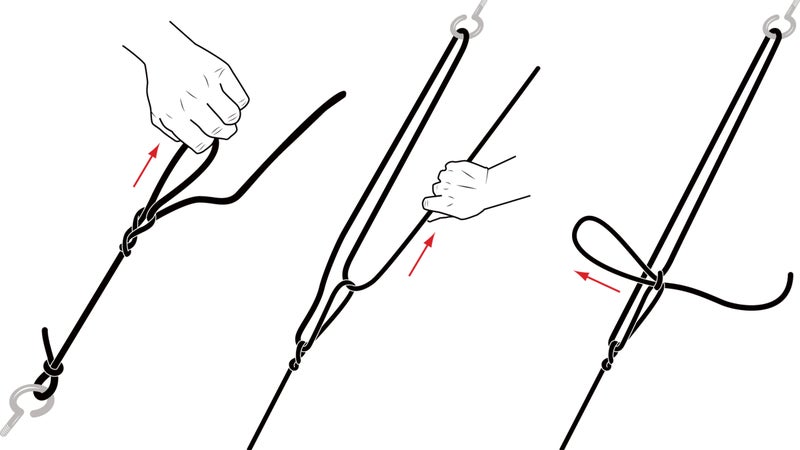
24. Tie Your Gear Down
Climbers, Boy Scouts, and sailors may disagree, but the —highly adjustable and capable of piano-string tightness—is the handiest knot on the planet.
- Secure one end of a rope to your first tie-down point. Then make a quick-release loop between it and your second tie-down point. To do this, grab a section of the rope in your hand and twist it clockwise three times, then pull a section of slack line through it until you have a taut loop.
- Thread the loose end of the rope through the second tie-down point, then back through the loop you just made, and pull to tighten.
- Once you’ve got the line as tight as you like, clamp down on the loop with your thumb and forefinger, then finish the knot by wrapping a section of loose line around the taut line and pulling it through. To undo, simply tug on the loose tail of line to unravel the whole package. (Or, to really lock off the end, wrap the new loose loop you created around the taut line and pull it through.)
—M.A.
25. Dodge Montezuma’s Revenge

Chef Andrew Zimmern, host of the Travel Channel’s , has put more potential contaminants in his mouth than a Manhattan raccoon: live lemon ants in Ecuador’s Napo River basin, seal stew in the Yup’ik villages of Alaska, fresh mangrove worms in Palawan . . . And yet he’s never gotten the trots while on the road. What sorcery is this? Zimmern explains: “Use the New York City hot dog theory of eating: Buy your food from the folks with the longest lines, highest turnover, and best reputations. Let your instincts guide you: Hot foods should be hot, cold foods should be cold, and anything that smells bad should be questioned. Be sure your purveyor/shop-keeper/waiter can tell you where the item is from. And remember: If it looks good, eat it!” (And, duh, drink bottled water.)
—J.D.
26. Acclimatize Like a Pro
As you gain altitude, your red blood cells can’t hold as much oxygen, which means once you start get- ting into the thousands of feet above sea level, you may get easily winded, have a headache, and feel nauseated. Go really high—like, say, 20,000 feet and up—and your head might feel like it’s going to implode, you might puke, your lungs might fill with fluid, and you might die. Eight-time Everest summiter Dave Hahn and expedition doctor Deirdre Galbraith share some pointers on going up the right way.
- Take your time: Nothing is proven by initial displays of physical prowess; walk at a pace that allows conversation and comfortable breathing. Your sleeping altitude shouldn’t increase by more than about 1,000 feet a day; plan on active rest (like light exercise around camp) every third day.
- Drink up: It’s crucial to take in plenty of fluid when the air is dry and your lungs are working overtime. Drink three liters a day; you should be peeing pale and frequently.
- Chow down: Appetite tends to decrease at altitude, but you’ve got to eat regularly to maintain strength, endurance, and warmth. A high-carb diet of 4,000 to 6,000 calories a day works best.
- Pay attention: If you develop symptoms of altitude sickness, take a rest day to allow your body to acclimatize. If you experience extreme symptoms, head to a lower elevation immediately.
- Party non: Booze up top is a bad idea. It will hurt acclimatization and increase your risk of dehydration.
- Just say maybe to drugs: There isn’t yet some magical cure for altitude sickness, but can be used responsibly and effectively. For instance, 125 mg at night before you sleep can help ease breathing and allow for more rest.
27. Reach Out Anywhere
Sometimes it takes more than a cell signal: Climbing in Europe and you want to keep up with that lass who offered to show you around Prague? You need a phone with GSM (Global System for Mobile), like Motorola’s new Motorizr Z3 ($250; $99 with rebates; ). You also need Telestial’s Explorer SIM Card ($59; ), with free incoming calls in 43 countries, plus just 55¢ per minute for outgoing calls.
- Doing business in China but need to be in e-mail and phone contact with offices in New York and Milan? You need a quad-band, GSM-enabled PDA, like BlackBerry’s new 8800 ($300; ), which comes with built-in GPS and an expandable 64MB memory.
- Sea-kayaking off Chile when an iceberg sinks your boat? You need Iridium’s 9505A satellite phone ($40 per week; ).��
- Trekking to Everest Base Camp and you want to post a video on YouTube … of that very drunk Czech making snow angels? You need the high altitude package: PDA, sat phone, camera, chargers, and cables in a durable carry-all case ($3,301; ).
—M.M.
28. Ride in a Peloton
Former elite road and velodrome cyclist—and now coach for hire— has taught thousands of newbies and pros how to pedal in a pack. So before you roll with a club, master his list of essential skills with a couple of experienced (and forgiving) riding buddies: Keep your front wheel six inches to a foot behind the rear wheel of the rider ahead of you. Focus on his hips.
- Etiquette for passing and other movement varies from group to group, but one rule is king: Surprises are bad, so be predictable.
- Only the lead rider can see potential dangers, so safety depends on communication, with riders calling or pointing out obstacles. Stay alert and quickly pass warnings down the line.
- Downshift before red lights or you’ll get dusted when it turns green.
- Don’t slam on the brakes, look down, space out, or overlap your front wheel with rear wheels. Ever.
Spit in the Pack
As peloton protocol goes, clocking the guy behind you with a loogie ties with sulfuric flatulence for the ultimate no-no. Avoid this gaffe by spitting like a pro:��
- Lean forward slightly and bow your head to one side.
- Extend your arm toward the ground, palm forward.
- Spit in front of your arm, which will block any spray.
29. Be a Dancing King

Samba in Brazil, waltz in Austria, Bollywood in India, tango in Argentina, swing in the U.S., polka in Germany, reggae in Jamaica, hip-hop in Kenya, mambo in Cuba … The world is your dance floor; be not afraid. Stepping on toes in five continents over the past decade, your dedicated correspondent (and Out of Bounds columnist)
Eric Hansen has formulated a few principles that will allow you to fake it or flaunt it. Anywhere. Let them be your passport to cavort: Your goal is—always and only—to make her look good. Usually, that means not embarrassing yourself while you let her do her thing: stomp, shimmy, spin like she’s in a hair-product commercial.
- If you’re dancing in a country that writes its name in roman letters, you can usually default to a four-step side-to-side. Elsewhere—remote Nepal, for example—mimic the men.
- Clubbing? Always keep your hands above your elbows. But don’t make fists; relax and pretend like you’re holding an egg in each hand.
- In all partner dances besides swing, the dip should be employed with restraint and class; at the beginning, it’s dramatic; the middle, surprising; the end, glamorous.
- Make your partners look hot and they should increase in hotness.

30. Prepare a Wild-Caught Rabbit for a Meal
By Jack Handey
The first thing you want to do, after catching a wild rabbit, is to calm the rabbit down. A panicked rabbit does not make for a pleasurable dining experience. It taints it. Pet the rabbit. Maybe say something soothing, like “Easy, Brownie, easy” (if the rabbit is brown) or “Easy, Gray Boy, easy” (if the rabbit is gray). You might just say, “Easy, little bunny.” (But, really, can’t you come up with some kind of name besides “bunny”?)
Feel the belly. It should be plump and fuzzy. But skinny is fine, too. Feel the ears. They should be soft and pink. Man, I love the ears.
If you like your rabbit spicy, try rubbing him with wild sage or wild mint.
Place the rabbit on a rock with good drainage. Next, take out a long, sharp butcher knife. Try not to let the rabbit see the knife. You may not want to look at the knife yourself, as some of them are kind of scary-looking.
Hold the rabbit down firmly with one hand. With the other hand, take a carrot out of your backpack. Still holding the rabbit, place the carrot on the rock and slice it with the butcher knife. Then feed the carrot pieces to the rabbit. If the rabbit doesn’t eat all the pieces, feel free to eat the leftovers.
Let the rabbit go. For fun, throw the knife at a tree trunk, to see if you can make it stick, like Jim Bowie or something.
(P.S. The reason you want a rock with good drainage is in case he pees.)
—Telling people how to do things is what Jack Handey loves best.
31. Compete in Costume
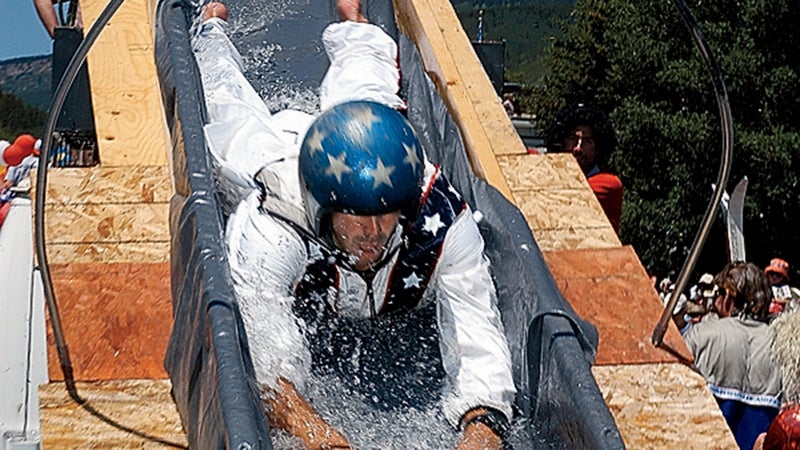
Because nothing takes the edge off like making a fool of yourself. The trick is an outfit that lets you finish with a time you can live with. Crested Butte, Colorado, mayor Alan Bernoltz has entered ski races as a sumo wrestler, a trash can, and (his personal fave, pictured) Evel Knievel, among other things, for going on 20 years. His advice: How much are you willing to suffer? If the answer’s “not much,” just wear a cape or a funny hat.
- Avoid face paint. It will sweat off and blind you.
- Will the wind shift your balance? ditch the wings.
- Cotton doesn’t keep you warm in storms. Incorporate performance fabrics.
- Make sure you have full range of motion. And visibility.
- Test everything before the race.
- When you’re dressed like a cartoon character, it just makes the people you pass go that much harder. Remember this.
—M.M.
Caped Crusades
2007: Nashville’s I Run for Music City 5K & 10K Run/Walk (July 4; ), Seattle’s World Naked Bike Ride (July 14; ), Chicago’s Muddy Buddy Ride and Run (August 5; ). 2008: Crested Butte’s Al Johnson Memorial Uphill/Downhill Telemark Ski Race (March 24; ), Jackson Hole’s Pole, Pedal, Paddle (April 5; ), San Francisco’s ING Bay to Breakers 12K (May 18; ).
32. Buy a Wetsuit

The trick is a Speedo and two plastic grocery bags. Seriously. The Speedo is for hygiene: Think of the many (hairy, promiscuous) surfers and divers who may have tried that wetsuit on before you. Boxers and boardshorts will just bunch up and throw off the fit.
- Pull the bags over your feet to slip into suits easily, and try several different brands; each has a unique shape. Also, peeling yourself out of a wetsuit is sweaty work, so don’t plan to try on more than three per outing.
- The fit needs to be very snug, since your suit will stretch out in water. Make sure neoprene isn’t piling up around your elbows or knees. The neck should be comfortable, and watch for tightness in the underarms. Swing your arms around to simulate paddling. Feel rubbing? Don’t buy.
- Once you’ve made your choice, lose the speedo.
—M.A.
33. Ski the Beach
I live on an island off North Carolina, and I’m the freak of my neighborhood. I’m the guy who . It started one day when I was jogging along the shore, knees and back aching. Since moving from New England, I’d missed snow and mountains, and as I stared at the flat sandbar I found myself longing for cross-country skiing, with its velvety rhythm. I looked at the sand again and thought, Why not? Step one is getting over any embarrassment. (Hey, , winner of Olympic cross-country silver in 1976, skied beaches in Hawaii.)
- Classic wax skis work best, but don’t overspend; sand and shells are harsh.
- Choose your beach wisely. You want long, rockless stretches.
- Ski at the water’s edge or on the finely crushed shells that can accumulate below the wrack line.
- The glide on a beach isn’t quite as glidey as snow, so spray silicon on your skis. [See Gessner in action; head to youtube.com and search “skiing the beach.”]
34. Pull Off a Mustache

Phil Olsen, founder of , which competes in the biennial , says: “Don’t shave at all for a few weeks. Allow the mustache to freely extend beyond the corners of your mouth. There will be a point when the hairs get in the way of food or drink—you’ll have to deal with that.”
- As it gets longer, Olsen says, choose a style and start experimenting with gels, waxes, and unscented hairspray. What works best depends on your facial structure; small facial features warrant smaller mustaches, a big nose can handle a real push broom, square faces should sport squared-off cuts, and round faces need to go round.
- The most important ingredient in a ’stache is attitude: Be proud of your mouth mane! “The majority of women don’t like it,” admits Olsen. “But the minority who do … well, they really ���.”
—J.D.
Shave Like a Gent

Scraping your face with some ten-dollar, six-blade landfill fodder and calling it shaving is like squirting ketchup into hot water and calling it tomato soup. Get a safety razor: One blade, two edges, genius. The best—vintage Gillette Adjustables with nine settings—are for cheap.
- Get some glycerin soap: ’s almond, with avocado oil and vitamin E, is tops (3.75 oz, $5.50—you can pick up some mustache wax while you’re there).��
- Get a badger brush: Sheared winter coat is best, and pricey, but drop $50 to $100 on any nice pure badger, like a , and you won’t be sorry. Get a stand and store your brush bristles down; treated right, it’ll last decades.
- Get your shave on: Take a shower or soak a washcloth in hot water, slap it on your acreage, and percolate a while to soften your beard. Run a couple of pints of hot water into the sink; wet your brush, give it a shake, and swirl it around on the soap cake to get some lather going; then paint your face up and down, lifting hairs and creating a barrier between blade and skin.
- Get the technique right: Using little strokes, and not pressing down, shave with the grain of your beard, as if sweeping; alternate edges and clean your razor by swirling it around in the water every few strokes. Rinse your face with cold water, to close up your pores, then pat dry. Simple witch hazel makes great aftershave.
- Bid adieu to razor burn and ingrowns.
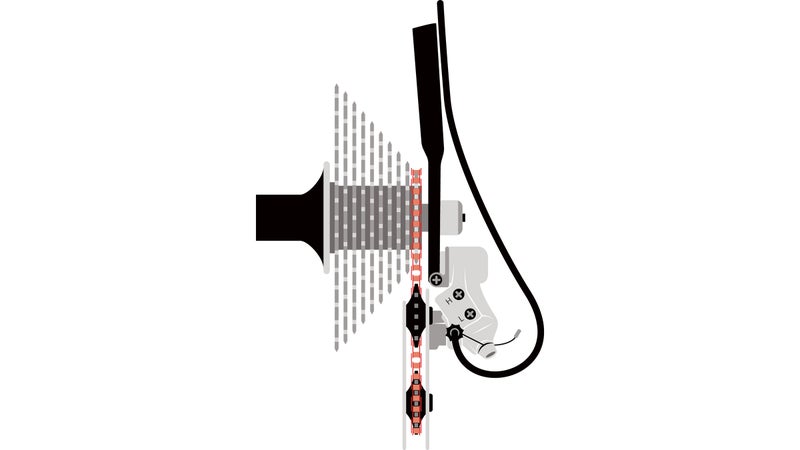
35. Tune Your Derailleur
It looks pretty scary: cables, gears, chains, grease, and springs. Who wants to mess with that? But the majority of shifting issues (jumping chains, rough shifts, clacking) can be fixed fast with zero tools. So next time your shifting goes, follow these steps from cycling guru Lennard Zinn, a former U.S. National Team rider and the author of on bicycle maintenance:��
- Determine whether you need to tighten or loosen the cable. Shift up until the chain is on the smallest cog in the rear, then downshift one gear. If the chain doesn’t climb to the next cog, or if it does so slowly, you need to increase tension. If it over-shifts, you need to reduce it.*
- Find the barrel adjuster. It’ll be at the rear derailleur (most likely) or by the handlebars.
- To increase tension, turn the barrel adjuster counterclockwise (when viewed from the end where the cable housing enters the adjuster). To reduce tension, turn clockwise. The barrel adjuster will click as you turn it. Go one or two clicks and recheck the shifting. Repeat until the chain moves easily in both directions.
*This holds true for most derailleurs. But some, called “low normal,” work in the opposite direction, with cable tension moving the chain away from the wheel, instead of toward it. To determine which kind you have, pull on the cable and watch which way the derailleur moves. If you have an LN, start on the largest cog and reverse this whole process.
36. Extract a Tick from Your Junk

By Wells Tower
You consider yourself a gentleman, and so it’s important, when you wake up with a stranger in your underpants one remorseful summer morning, that you manage the matter with due delicacy and grace. What complicates things is that it’s not a fellow Homo sapiens you brought home last night but a Dermacentor variabilis, which translates roughly to “moody flesh nibbler,” a.k.a. the American dog tick.
Yes, you exercised poor judgment, but it’s too late to worry about that. She’s already gotten herself attached—way, way too horribly attached—to the tenderest organ known to men. You hate to be caddish, given the intimacies you’ve already shared, but be honest with yourself: You two simply don’t have a future together. Don’t be drawn in by that transparent “Oh, but I’m so tiny and vulnerable” routine. She’s a parasite, no two ways about it. She knows she’s got a good hustle going here, and she won’t leave you alone until she’s bled you to a husk.
You both could use a drink. Pull that pint of Kentucky Gentleman out of your liquor cabinet (no need to waste the Knob Creek). Take a strong dose yourself, then tilt the lip of the bottle against your little visitor. Hold it there for 90 seconds or so. Give her a nice long slug. Never mind the sting.
Ah, now she’s feeling no pain. If her head weren’t buried in your special purpose, you’d see a little woozy smile dawning on her face. Head for the bathroom. Take out your trusty Revlon needlenose tweezers. Now get a good grip, close to the jaw, and pull. That’s a good girl. Let it go.
Now she’s gazing at you, pinched in the tweezers’ grasp, her eyes dark with the fury of the scorned. But a quick goodbye is what the occasion calls for. Grab the book of matches on the back of the commode and set her tactfully on fire.
—Wells Tower stresses that he has never hosted any other type of insect within his trousers.


